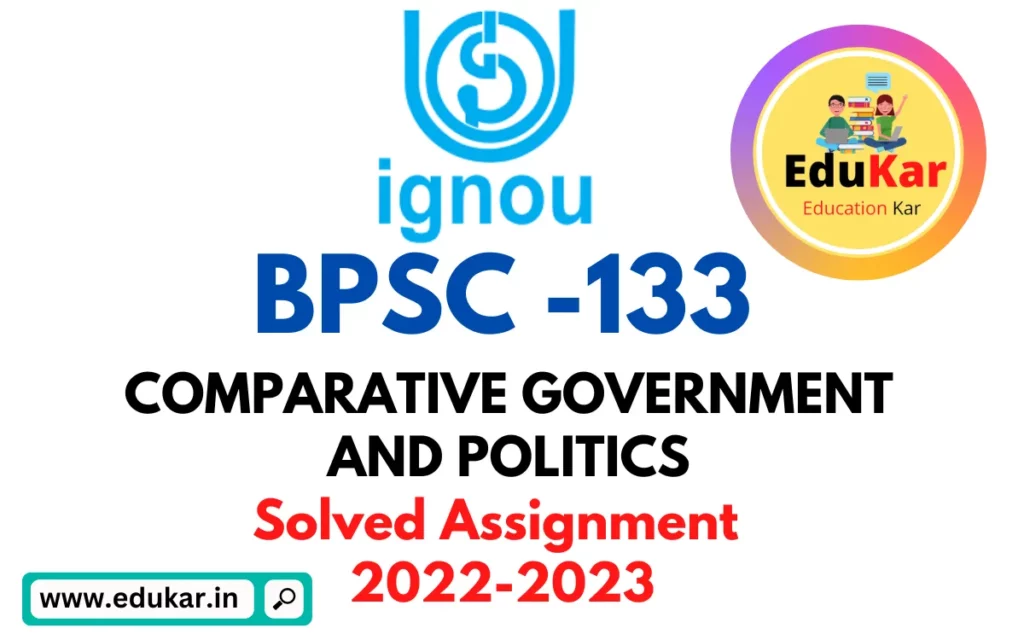Contents
- 1 Assignment – I
- 2 Answer the following in about 500 words each.
- 3 1. Analyse the causes for the rise of Marathas.
- 4 2. Discuss the growth of Vaishnava Bhakti in India during the 16th-17th centuries.
- 5 Assignment – II
- 6 Answer the following questions in about 250 words each.
- 7 3. Examine the centrality of Indian subcontinent in the Indian Ocean trading Network during the 16th-17th Centuries.
- 8 4. Write a note on the main characteristics Deccan Paintings.
- 9 5. Discuss briefly the Mughal-Sikh relations in the seventeenth Century.
- 10 Assignment – III
- 11 Answer the following questions in about 100 words each.
- 12 6. Noorjahan
- 13 7. The Great Divergence Debate
- 14 8. Textile production
- 15 9. Mughal public works (Sarais & Bridges)
- 16 10. Shaikh Amhad Sirhindi

| Title | BHIC-112: IGNOU BAG Solved Assignment 2022-2023 |
| University | IGNOU |
| Degree | Bachelor Degree Programme |
| Course Code | BHIC-112 |
| Course Name | HISTORY OF INDIA-VII (c. 1605-1750) |
| Programme Name | Bachelor of Arts (General) |
| Programme Code | BAG |
| Total Marks | 100 |
| Year | 2022-2023 |
| Language | English |
| Assignment Code | BHIC-112/ASST/TMA/2022-23 |
| Last Date for Submission of Assignment: | For June Examination: 31st April For December Examination: 30th September |

Assignment – I
Answer the following in about 500 words each.
1. Analyse the causes for the rise of Marathas.
Ans: The rise of the Maratha empire in India was a result of a combination of factors, including political, social, economic, and military.
One of the main causes of the rise of the Maratha empire was the decline of the Mughal empire. The Mughal empire was at its peak in the 17th century but by the 18th century, it had begun to decline. This decline was due to a number of factors such as weak rulers, administrative corruption, and a lack of military power. The Maratha empire, on the other hand, was rising in power and was able to fill the vacuum created by the decline of the Mughal empire.
Another important factor was the growth of the Maratha army. The Maratha army was a well-disciplined and well-equipped force, which was able to challenge the Mughal army. The Maratha army was led by capable leaders such as Shivaji, Baji Rao I, and Sambhaji, who were able to inspire and motivate their soldiers. The Maratha army was also able to adapt to changing conditions and incorporate new tactics and weapons.
The Maratha empire was also able to expand its influence through diplomacy and alliances. The Maratha empire was able to form alliances with other states and kingdoms, which helped to increase its power and influence. The Maratha empire was also able to use its diplomatic skills to negotiate favourable terms in treaties and agreements with other states.
Another factor that contributed to the rise of the Maratha empire was the support of the rural population. The Maratha empire was able to gain the support of the rural population by addressing their needs and concerns. The Maratha empire implemented policies that helped to improve the lives of the rural population, such as reducing taxes, improving irrigation systems, and promoting agriculture.
Lastly, the rise of the Maratha empire was also due to the cultural and religious influences of the region. The Maratha empire was deeply rooted in Hindu culture and religion, which helped to gain the support of the Hindu population. Hinduism was also a source of inspiration for the Maratha leaders, who saw themselves as protectors of Hinduism against the Mughal empire, which was predominantly Muslim.
Ans: The growth of Vaishnava Bhakti in India during the 16th and 17th centuries was a major cultural and religious development in India’s history. Vaishnava Bhakti is a devotional movement within Hinduism that was centered around the worship of Lord Vishnu, one of the major Hindu deities. The movement was characterized by its emphasis on devotion and love for God, rather than ritual and ceremony.
The growth of Vaishnava Bhakti was a response to the social and cultural changes that were taking place in India during the 16th and 17th centuries. The period was marked by a decline in the power of the Mughal empire, which had been the dominant force in India for several centuries. This decline was accompanied by a growing sense of disunity and social unrest, as different communities and religions vied for power and influence.
The growth of Vaishnava Bhakti provided a sense of spiritual solace and unity for the Indian people. The movement offered a new way of understanding and relating to God, which emphasized personal devotion and the experience of divine love. This was a departure from the more formal and ritualistic approaches to religion that were prevalent at the time.
The growth of Vaishnava Bhakti was facilitated by the proliferation of devotional literature, such as hymns, poems, and songs, which were written in local languages and were easily accessible to the common people. These works were highly emotive and evocative, and they encouraged people to express their love and devotion to God through singing, dancing, and other forms of worship.
The growth of Vaishnava Bhakti was also influenced by the teachings of several important saints and spiritual leaders. These leaders, such as Ramananda, Kabir, and Chaitanya, travelled widely and spread the message of Bhakti throughout India. They attracted large followings and their teachings were widely accepted, even by people from different social and religious backgrounds.
The growth of Vaishnava Bhakti had a profound impact on Indian society and culture. The movement challenged the traditional social and religious hierarchies and encouraged the breaking down of barriers between different communities and castes. It also helped to promote a sense of unity and common purpose, as people from different backgrounds came together to worship and sing the praises of Lord Vishnu.
Assignment – II
Answer the following questions in about 250 words each.
3. Examine the centrality of Indian subcontinent in the Indian Ocean trading Network during the 16th-17th Centuries.
Ans: The Indian subcontinent was at the center of the Indian Ocean trading network during the 16th and 17th centuries. This region was strategically located at the crossroads of the major trade routes connecting East Asia, the Middle East, Africa, and Europe. It was a hub of commercial and cultural exchange, attracting merchants from all over the world who came to trade spices, textiles, precious stones, and other goods.
One of the key factors that made the Indian subcontinent so central to the Indian Ocean trading network was its rich and diverse natural resources. Spices such as black pepper, cinnamon, nutmeg, and cloves, which were in high demand in Europe and the Middle East, were produced in the region. Indian textiles, especially those made of silk and cotton, were also in high demand, especially in the Islamic world. The subcontinent was also a major producer of precious stones, such as diamonds and rubies, which were highly valued in Europe and Asia.
The subcontinent’s centrality to the Indian Ocean trading network was also due to its location on the key trade routes that connected the East and West. The subcontinent’s ports, such as Calicut, Surat, and Hugli, were major commercial centers that attracted merchants from across the world. These ports were also home to cosmopolitan communities of traders and merchants, who facilitated the exchange of goods, ideas, and cultures.
In addition, the subcontinent was home to several powerful empires, such as the Mughals, that played a crucial role in shaping the Indian Ocean trading network. These empires maintained large and efficient navies that helped to ensure the security of the trade routes, while also acting as a stimulus to trade by promoting commercial policies that encouraged merchants to trade in the region.
4. Write a note on the main characteristics Deccan Paintings.
Ans: Deccan paintings refer to a style of Indian miniature paintings that developed in the Deccan plateau region during the sixteenth to the eighteenth centuries. These paintings are known for their vibrant colors, intricate details, and rich storytelling. The following are the main characteristics of Deccan paintings:
- Use of vibrant colors: Deccan paintings are characterized by the use of rich, bold, and vibrant colors that are used to create an overall harmonious composition. The palette used in Deccan paintings was dominated by red, blue, green, yellow, and gold.
- Elaborate details: Deccan paintings are known for their intricate details and meticulous execution. The artists used fine brushwork and delicate lines to create highly detailed images of animals, flowers, trees, and other elements of nature.
- Depiction of everyday life: Deccan paintings often depict the everyday life of the people of the region, including their customs, traditions, and social norms. The paintings showcase a wide range of scenes, including religious ceremonies, domestic activities, and royal events.
- Use of Persian elements: Deccan paintings have a strong influence of Persian art, as many of the artists who created these paintings were trained in the Persian tradition. This influence is evident in the use of Persian themes, such as courtly life, as well as in the stylistic elements of the paintings.
- Storytelling: Deccan paintings are known for their rich storytelling, as they often depict scenes from Hindu mythology, Islamic legends, and other traditional stories. The paintings provide a visual representation of these tales, which adds to their cultural and historical significance.
5. Discuss briefly the Mughal-Sikh relations in the seventeenth Century.
Ans: The relationship between the Mughals and the Sikhs in the seventeenth century was complex and marked by both cooperation and conflict. The Mughal Empire, which dominated the Indian subcontinent, was founded by Babur in 1526 and lasted until 1857. On the other hand, the Sikh religion and community emerged in the Punjab region in the late fifteenth and early sixteenth centuries and gradually gained strength as a political and military force.
In the early seventeenth century, the Mughal emperors and the Sikh gurus maintained a cordial relationship, with the Mughals recognizing the Sikh gurus as spiritual leaders and the Sikhs offering their support to the Mughal regime. However, as the seventeenth century progressed, tensions began to arise between the two groups. The Mughal authorities became increasingly hostile towards the Sikhs, perceiving them as a potential threat to their rule. In response, the Sikhs became more assertive in their demands for political and religious freedom.
The most significant conflict between the Mughals and the Sikhs took place during the reign of Emperor Aurangzeb, who ruled from 1658 to 1707. Aurangzeb was a devout Muslim who sought to impose his religion on his subjects and saw the Sikhs as a challenge to his authority. He launched several military campaigns against the Sikhs and persecuted them, leading to widespread violence and destruction. The Sikhs, in turn, resisted the Mughal aggression and formed a guerrilla army to defend their rights and beliefs.
Despite the conflicts, the Mughal-Sikh relations in the seventeenth century were also marked by instances of cooperation and mutual respect. For example, some Sikh warriors served in the Mughal army, while others maintained friendly relations with Mughal officials and even helped to resolve disputes between rival factions. In some cases, Mughal emperors even sought the assistance of Sikh leaders in resolving political and military problems.
Assignment – III
Answer the following questions in about 100 words each.
6. Noorjahan
Ans: Noorjahan was a legendary queen who ruled with grace and wisdom. She was known for her exceptional leadership skills and her love for her people. She implemented policies that brought prosperity and peace to her kingdom, earning her the title of the “Queen of Light”. She was also an patron of the arts, and under her reign, music and literature flourished. Noorjahan was a symbol of strength and courage, inspiring countless women to pursue their dreams and ambitions. Her legacy lives on through the generations and serves as an inspiration to all those who seek to make the world a better place.
7. The Great Divergence Debate
Ans: The Great Divergence debate is a discussion among economists and historians about the reasons behind the relative economic success of the West compared to the rest of the world, particularly Asia. This debate focuses on the reasons why the West, and in particular Europe and North America, were able to achieve economic dominance during the 19th and 20th centuries, while many other regions, including Asia, remained largely underdeveloped.
The debate over the Great Divergence has been ongoing for many decades and there are many different explanations for this phenomenon. One of the main explanations is the influence of institutions and culture, with some scholars arguing that the West’s institutions and culture, such as private property rights and the rule of law, were more conducive to economic growth and development. Others point to the importance of technological innovation, suggesting that the West was able to develop new technologies and innovations at a faster pace than other regions, which helped to spur economic growth.
Another explanation for the Great Divergence is the influence of colonialism and imperialism, with some scholars arguing that the West’s exploitation of other regions, including Asia, helped to support the West’s economic growth while preventing the development of other regions. Some also point to the impact of geographic factors, such as access to resources and the availability of transportation and communication networks, as playing a role in the Great Divergence.
There are many different interpretations of the Great Divergence debate, and the topic continues to be the subject of much discussion and debate among scholars. Some argue that the factors that led to the Great Divergence are complex and interrelated, and that there is no single explanation that can fully explain the phenomenon. Regardless of the cause, the Great Divergence remains an important topic of study, as it has had a profound impact on the global economy and has shaped the development of many different regions around the world.
8. Textile production
Ans: Textile production was a significant industry in the Mughal Empire, and played a major role in the economy of the empire. The Mughals were known for producing a wide range of textiles, including silk, cotton, and wool, which were highly valued for their quality and beauty. The Mughal court was a major center of textile production, and many of the finest textiles were produced for the use of the emperor and his court.
Textile production in the Mughal Empire was a complex and highly organized industry, with skilled workers and specialized artisans working together to produce high-quality textiles. The Mughals established a system of guilds and workshops, which regulated the production of textiles and ensured that quality standards were met. The Mughal court also supported the development of new techniques and designs, which helped to keep the industry at the forefront of innovation.
The Mughal textiles were highly sought after, both within the empire and beyond its borders. The Mughals traded their textiles with other countries, and they were particularly prized in Europe, where they were used for clothing, furnishings, and other luxury items. Textile production was also a major source of revenue for the Mughal Empire, and the trade of textiles helped to fund the empire’s military conquests and other endeavors.
9. Mughal public works (Sarais & Bridges)
Ans: The Mughals were known for their impressive public works projects, which included the construction of sarai and bridges. Sarai refers to a type of inn or caravanserai, which served as rest stops for travelers along the roads and highways of the Mughal empire. These sarai were usually located near major cities and provided travelers with a place to stay, food and drink, and other necessities during their journeys. They were often built near major trade routes, and were important centers of commerce and culture.
Mughal bridges were also important public works projects. The Mughals built many bridges across the rivers and streams of their empire, which helped to facilitate the movement of goods and people. These bridges were often built as part of wider road networks, and were used to cross difficult terrain, such as mountains and valleys. Many of these bridges were architectural marvels, with impressive arches, towers, and other decorative elements.
Both sarai and bridges played an important role in the development and expansion of the Mughal empire. They helped to improve trade and commerce, and allowed the Mughals to control and regulate the movement of goods and people throughout their empire. These public works projects also helped to establish the Mughals as a powerful and prosperous empire, and demonstrated their commitment to improving the lives of their subjects. Today, many of these structures still stand and serve as reminders of the impressive architectural and engineering skills of the Mughals.
10. Shaikh Amhad Sirhindi
Ans: Shaikh Ahmad Sirhindi was an Indian Islamic scholar and Sufi saint who lived in the late 16th and early 17th centuries. He was born in Sirhind, in present-day Punjab, India, and was a prominent figure in the Naqshbandi Sufi order. Sirhindi is best known for his efforts to revive traditional Islamic teachings and practices, which he saw as having been corrupted by the influence of Hindu and other non-Islamic ideas. He advocated for a puritanical form of Islam, emphasizing the strict adherence to Islamic law and the rejection of syncretic beliefs and practices. Sirhindi’s ideas had a significant impact on the development of Islamic thought in India, and he is considered one of the leading figures of the “Sunni revival” movement in the country.
How to Download BHIC-112 Solved Assignment?
You can download it from the www.edukar.in, they have a big database for all the IGNOU solved assignments.
Is the BHIC-112 Solved Assignment Free?
Yes this is absolutely free to download the solved assignment from www.edukar.in
What is the last submission date for BHIC-112 Solved Assignment?
For June Examination: 31st April, For December Examination: 30th October
















